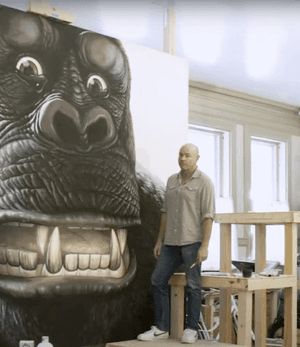Walton Ford
Walton Ford is a contemporary American artist known for his large-scale wildlife paintings that blend realism with surrealist elements. Born in 1960 in Larchmont, New York, Ford grew up in a family of ornithologists, which sparked his lifelong fascination with animals and the natural world. After completing his undergraduate studies at the Rhode Island School of Design, Ford moved to New York City to pursue a career in illustration.
He quickly established himself as a sought-after illustrator, creating artwork for numerous publications, including The New York Times, The New Yorker, and Vanity Fair. However, he soon became disillusioned with the commercial aspects of the art world and turned his attention to painting. Ford's paintings are meticulously detailed and often feature large animals in dramatic, sometimes violent, settings. His use of vivid colors and intricate patterns draws the viewer in, while the realism of his depictions adds weight and emotional resonance to his work. Many of his paintings include elements of allegory and satire, often commenting on the exploitation of the natural world by humans.
One of Ford's most famous works is the painting "Tyger Tyger," which depicts a massive Bengal tiger leaping through the air, surrounded by a chaotic scene of other animals, including a crocodile, a zebra, and a vulture. The painting's title is a reference to William Blake's poem "The Tyger," and the work as a whole is a commentary on the destruction of natural habitats and the threat of extinction faced by many of these animals. Another notable work by Ford is "The Island," which portrays a group of monkeys inhabiting a small island, surrounded by a sea filled with ships and oil rigs. The painting is a commentary on the destruction of natural environments, as well as a reflection on the isolation and vulnerability of individual creatures in the face of human progress.
Ford's work has been exhibited in numerous galleries and museums throughout the world, including the Whitney Museum of American Art in New York and the Smithsonian American Art Museum in Washington, D.C. In addition to his paintings, he has also created sculptures and installations that explore similar themes. Despite the sometimes dark subject matter of his work, Ford's paintings are often infused with a wry sense of humor and a deep appreciation for the beauty and complexity of the natural world. His art serves as a reminder of the importance of preserving our planet's ecosystems and the animals that inhabit them.
Today, Walton Ford is widely regarded as one of the most important contemporary wildlife artists, and his work continues to inspire and provoke viewers around the world. His unique blend of realism and surrealism, combined with his deep knowledge of and passion for the natural world, make him a truly unique and compelling figure in the world of art.
Featured Artists
- Albers Anni
- Ancart Harold
- Andre Carl
- Avery Milton
- Baldessari John
- Barnes Ernie
- Calder Alexander
- Castellani Enrico
- Clough Prunella
- Crawford Brett
- Dadamaino
- de Tollenaere Saskia
- Dyson Julian
- Elsner Slawomir
- Freud Lucian
- Gadsby Eric
- Gander Ryan
- Guston Philip
- Haring Keith
- Hartung Hans
- Hayes David
- Held Al
- Hepworth Barbara
- Hill Anthony
- Hitchens Ivon
- Hockney David
- Hutchinson Norman Douglas
- Jenney Neil
- Katz Alex
- Kentridge William
- Knifer Julije
- Kusama Yayoi
- Le Parc Julio
- Leciejewski Edgar
- Léger Fernand
- Levine Chris
- Marchéllo
- Martin Kenneth
- Mavignier Almir da Silva
- Miller Harland
- Mitchell Joan
- Modé João
- Moore Henry
- Morellet François
- Nadelman Elie
- Nara Yoshitomo
- Nesbitt Lowell Blair
- Nicholson Ben
- O'Donoghue Hughie
- Pasmore Victor
- Perry Grayson
- Picasso Pablo
- Pickstone Sarah
- Prehistoric Objects
- Riley Bridget
- Ruscha Ed
- Sedgley Peter
- Serra Richard
- Shrigley David
- Smith Anj
- Smith Richard
- Soto Jesús Rafael
- Soulages Pierre
- Spencer Stanley
- Taller Popular de Serigrafía
- The Connor Brothers
- Vasarely Victor
- Vaughan Keith
- Whiteread Rachel
- Wood Jonas
